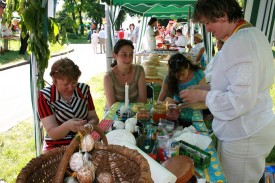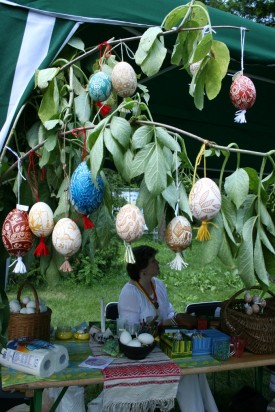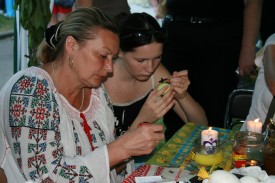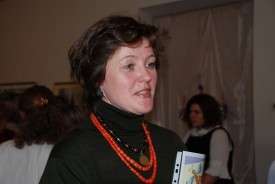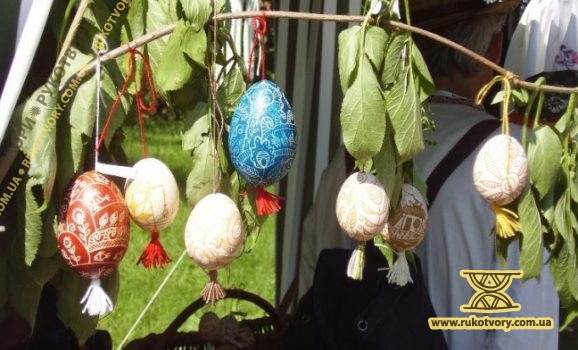
Note:
Pysanka – an Easter egg, painted using different dyes and wax; the word coming from the Ukrainian verbs pysaty, rozpysuvaty meaning to paint or to ornament.
Pysankar – artist who makes original pysankas.
Painted with the help of dye and wax Easter eggs – pysankas – can be called the brightest component of Easter. Ornamented with different signs and symbols, they carry joy and light to everyone: both to the people who ornament them and to those who just admire them. An unexplainable feature of a pysanka is the fact that any person, even most deeply upset or sad, will unintentionally smile when looking at pysankas.
How Easter eggs were ornamented by our ancestors, where they were used and whether there are many artists in Ukraine making pysankas nowadays were the questions I asked Tetyana Sosnovska who is an artist-pysankar and the director of Kiev literature and memorial museum – the apartment of a famous Ukrainian poet Pavlo Tychina.
On the day of my visit Tetyana was preparing to her master class in making pysankas which she was to hold with children suffering from cancer by the request of Renat Akhmetov’s charity fund “Development of Ukraine”. The artist was preparing presents for the children: she was putting books about egg painting and pysankas into separate bags for all of them.
— To my mind, ornamenting Easter eggs cannot be a private business; even more – it cannot be a business at all. I do not understand those artists who have quit their jobs, teaching or engineering work – whatever they used to do – and stay home painting eggs with the only purpose to sell them at an opportunity. Certainly, additional earnings is a pleasant thing and the work is necessary but I do respect the pysankars who teach others after having learned themselves and I take them as an example myself.
It is because ornamenting eggs is an ancient tradition, not invented by me or other pysankars. And if it timely came to our mind that this tradition can disappear and we need to continue it, to preserve it then it can be considered as a fate’s gift – this fact that we have timely understood and learned it. So one does not have any right to bottle oneself up in a private apartment or a studio, one should teach as many people as it is possible. After all, there have always been people teaching me and all the other pysankars, this knowledge hasn’t appeared out of the blue for them.
What are the legends or real facts about where and what pysankas were used?
I have read somewhere that an ornament on the green background used to be made only by old wise women treating people. Nowadays we use artificial aniline dye but in the old days only natural dye was used. Green color has always been a capricious one. A person should have had a good understanding of herbs to know what herb needs grinding and what needs stewing to have a nice green color on the egg shell. Green color is the color of life and health, so when wise women were actually “rolling out” an illness by an egg out of a person with prayers they were making it with pysankas having an ornament on a green background.
Pysankas with ornaments on the yellow background were painted somewhere after Easter by mothers whose small children had by some reason passed away during the previous year. I cannot explain why exactly on the yellow background. Yellow is the color of Sun. Maybe it was to pass sunny wishes to the children who were around. It seems that during the “Green” holidays mothers gave these pysankas out to children wishing them health; for them in their turn to pray for the dead children of these women.
Pysankas with ornaments on the red background have a very interesting history. Any mother with daughters in the family had to paint flowers on pysankas because the flower is an emblem of a girl and beauty. Sanctified in the Church, pysanka together with a coral necklace was placed into a bowl. The bowl was filled by sanctified, “holy” water and all the family washed their faces with this water. The girls were the first to wash their faces to be beautiful. Especially important this was for the girls at the age suitable for marriage.
Pysankas have symbols on them guarding the house against the illnesses and fires. Also, these were symbols which meant fertility and good harvest.
Pysankas were kept in the house during the entire year and when the following year in spring the land was plowed then the pysankas sanctified in the previous year were thrown into the plowed soil – for them to produce good harvest.
Besides, when a sanctified pysanka was brought from the church it was obligatorily put it close to the bees in the bee houses for the bees to hive well. Also, pysankas were fed to cattle or just placed somewhere in the cattle-shed. If a family had an infant then a special pysanka was painted for this very infant and placed into the cradle.
They say in the old days people started to ornament pysankas in the afternoon on the Maundy Thursday. The house was clean and neat, and the mother of the family sent her children out to play when sitting down to decorate eggs. She did it in order not to become angry with a child accidentally, not to shout at it and not to take a sin upon the soul because people used to start ornamenting eggs free from all the filth.
Do pysankars stick to these beliefs themselves?
In general, pysankars say to each other that if they are in low spirits then it is better not to start working because pysankas will not be good: either the artist’s hand will blunder or the paint will not stick to the shell or something else will happen.
As for me, I call the process of creating pysankas pysankatherapy. Because in whatever mood you are and whatever problems you have you forget about everything when starting to make pysankas. Maybe it really is that way because pysankas carry lucid ideas and bright hopes for the future so that they drive all the bad thoughts away.
And I think that those pysankars who are religious go to the church and pray before starting to create pysankas.
In the old days they used to say that before submerging the egg into the first dye it had to be placed into cabbage brine and it was necessary to say “Our Father” three times before taking the egg out of the brine. So that period of time was sufficient for the egg shell to start dissolving.
I make pysankas at home in my kitchen. I have my grand-grandmother’s icon in a corner there so even unintentionally I understand it is necessary to say a prayer and to ask for blessing before taking the pysachok (a special stick with metal or tin pen for applying hot wax) in my hands. It is necessary for the pysankas to be made in a good hour and with decent thoughts.
We know about pysankas but are krapankas (made by dropping hot wax on the egg shell and consequently submerging the egg into different dyes), dryapankas (with ornaments scratched out by a needle on the painted egg shells) and malyovankas (hand-painted) as widespread nowadays?
Malyovankas are not made nowadays, only the children who are too small to work with wax and fire and are not able yet to make pysankas paint them.
Dryapankas are usually made by old women; also art academy students and schoolchildren make good anecdotal dryapankas with pleasure. It’s only that nowadays they use thin handpieces for manual dental device beside needles, so the process is a bit unified and engineered. But the tradition of dryapanka remains. And though unfortunately it is not widespread there are places where it is still made.
And krapankas are very easy to make. One should only turn a burning candle upside down: the wax drops down on the egg and meanwhile in the process the egg is submerged into different dyes in turn.
But there are not many places where krapankas can be found…
They are considered to be very simple and primitive though actually the spots can look very nice: for example, you let the wax drop and the drop starts to flow and forms a shape of a tear or something else. Children like to make them very much. You say to them: let’s make 10-15 spots of wax and then place the eggs into the dye; but should you turn away from them for a second they will make spots all over the egg because they like the process of dropping.
Making straight lines on the egg shell seems very difficult. Is it possible for anyone to learn this?
I am sure that if there’s a wish then anyone can learn this. Last year I visited Ivano-Frankivsk region, Verkhovyna and Kosiv. Kosiv pysankas of the older days are not so much ornamented as the modern ones and the patterns did not have so many tiny details. I bought several Yavorove pysankas from an old woman from Verkhovyna. By their patterns these pysankas are completely different from the ones brought to us from that region nowadays – with accurate patterns having a lot of details. And when looking at such pysanka one can see a bit distorted or not completely strict line here or there; somewhere the lines are thinner and somewhere thicker. So it can clearly be imagined how an old woman takes a pysachok in her tired hands (as it may be difficult for her to bend her fingers because her hands hurt from work) and makes this ornament with a real pysachok. To me such pysanka is a hundred times more valuable, more beautiful and dear than contemporary ones with neat ornaments made by electric pysachok. So there is nothing wrong if some line becomes a bit distorted. If you want to have stricter lines you should continue learning hard.
When I teach children to ornament pysankas I tell them that all the signs on them have not been invented by me or the authors of the book; they have been used for hundreds and thousands of years. So each pysanka carries a bit of positive information: on pysankas you can find home guardians, trees of life, fertility; symbols of power if necessary and symbols of cognition of the world; then there is an equilateral cross and spots symbolizing seeds which will fall on the soil and grow through. I always tell children not to paint anything modern on pysankas – space ships or tractors – because the ancient symbols on pysankas which are there from the times of our ancestors have always been the most important ones in the wishes, so we should not modernize pysankas.
What is interesting is that practically everyone’s first pysanka turns out to be practically perfect. Maybe that is because each person carefully prepares for this, never hurries, washes his hands and the egg thoroughly and because this first act of decorating pysanka is a kind of a sacred rite for this person. But later a time comes when it seems you do everything right: your drawing is good and the egg is clean but should you place it into the dye – the dye doesn’t stick or an ornament becomes somehow spoilt or there’s something else. To my mind it is a probation period for the person. God tries all the people for them not to put on airs and to see whether a particular person will become disappointed with his passion and whether he is capable of overcoming all the difficulties and analyzing what he is doing right and what wrong. So practically everyone has such periods.
I as a museum official regret the fact that some of our pysankars are trying to improve the ornament with the electric pysachok so much that it obtains modern character and a kind of artificial synthetic look though maybe it is necessary in the process of the national art development – I do not know. Especially, I don’t recognize varnished pysankas though Canadians and Americans like them very much… That is because our national pysanka should be natural. And for it to glitter it is oiled or buttered but never varnished.
What are the regional features of pysankas?
Pysankas with a lot of small details and large amounts of yellow, orange, green and red are made in the Western Ukraine, Ivano-Frankivsk region and in the Carpathians. But if to look at the pysankas exhibited in museums and the ones made by elder people it will be seen they are much simpler.
In the Eastern and Central Ukraine pysankas had large-scale ornaments and they were mostly plant ornaments with fewer numbers of colors. For example there could be a red flower on the black background. By the way, black is the color of soil and not mourning.
There are no ancient pysankas preserved. The oldest existing ones are dated by the middle of the 19th century. By the time a significant migration of people had taken place and some woman from Western Ukraine may have married a man from Zhitomir or Kiev region, came to this area and started to make pysankas her way. Her ornament transformed, it was borrowed by her neighbors and now we cannot say whether this or that pysanka originate exactly from Kiev or Chernihiv region.
Here you can see books by Vira Manko (artist-pysankar from Lviv – auth). She made all attempts to categorize pysankas by the regions.
I know a lot of pysankars who strictly stick to the images communicated to us from books and collected during expeditions of different explorers. It is a guarantee that a definite number of people will preserve the tradition not only of the process of creating pysankas but of the patterns as well.
Is the tradition of making pysankas being restored in Ukraine?
The art of making pysankas is now concentrated in large cities: Lugansk nowadays is making pysankas; Dniepropetrovsk, Sumy and Vinnytsa do, and, for sure, a lot of people do this in different villages and cities in the Western Ukraine. I have a list of pysankars whom we want to invite to a festival in Kiev so it is seen from this list there are artists everywhere. And if to start writing down the names of the artists in Ivano-Frankivsk region then the ink in the pen will finish listing them all. Only in Cherihiv there are no pysankars. There was a woman who was making pysankas. She was invited to Canada once and she stayed there. So there are no people in Chernihiv nowadays who would be able to make a correct pysanka.
Zoya Stashuk went to Chernihiv to conduct master classes but no one knows if any person will continue with this work… Well, maybe the Church will join us so somehow this tradition will be maintained by Sunday schools and clubs.
I was talking to other pysankars and everyone understands that we need to search for opportunities of going to the country to teach children this tradition because a lot of the old women who used to make pysankas have passed away and the young people want to get back to their traditions but unfortunately they go to supermarkets and buy ready-made plastic stickers. First, that plastic sticker on a boiled egg does not have that sacral content which is contained in the pysanka, a whole egg which after having been sanctified can be safely stored for a year. And we need to tell our children that a painted egg is a thing for breaking religious fast, for food, but a pysanka with ancient symbols and signs should be stored for the entire year after the consecration.
Where did you learn the art of making pysankas?
I was taught by Zoya Stashchuk and Oksana Bilous. The story looked the following way: As soon as Lviv friendly association was founded in Kiev the people from it learned that our museum was situated in the center and we had spare space in it so no money was required; and with that fanatic of her job Tetyana Viktorivna (Tetyana Sosnovska – auth.) among them they proposed a children’s program for our museum: to gather children for different holidays and to tell them about the national traditions because a lot of people came here from Lviv region and their children grew so to say “on blacktop”, listened to a foreign language and all this troubled their parents.
So on the Easter eve we invited Zoya Stashchuk and Oksana Bilous to teach the children from the Lviv friendly association to make pysankas. Well you know that each grown-up person has a child in the heart. So I learned among the children…
I haven’t been making pysankas long – maybe for 7 or 8 years, not many. All the more I paint pysankas before Easter to make presents to everyone, to conduct master classes if there are people to teach and to present my pysankas to different churches and cathedrals for decoration.
Kateryna Kachur was talking to the artist
